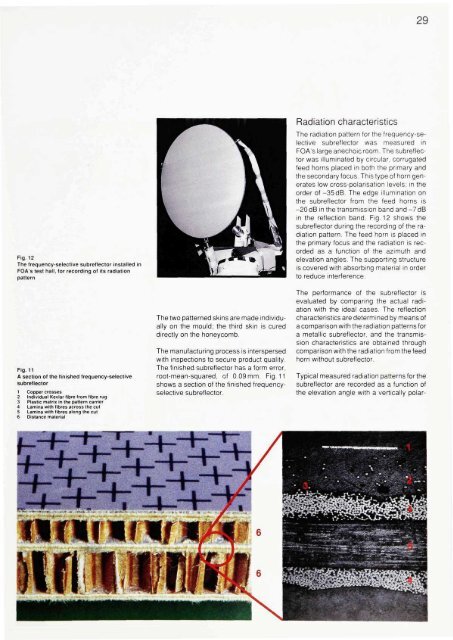Dichroic Antenna Reflector for Space Applications CCITT ...
Dichroic Antenna Reflector for Space Applications CCITT ...
Dichroic Antenna Reflector for Space Applications CCITT ...
You also want an ePaper? Increase the reach of your titles
YUMPU automatically turns print PDFs into web optimized ePapers that Google loves.
29Fig. 12The frequency-selective subreflector installed inFOA s test hall, <strong>for</strong> recording of its radiationpatternFig.11A section of the finished frequency-selectivesubreflector1 Copper crosses2 Individual Kevlar fibre from fibre rug3 Plastic matrix in the pattern carrier4 Lamina with fibres across the cut5 Lamina with fibres along the cut6 Distance materialThe two patterned skins are made individuallyon the mould; the third skin is cureddirectly on the honeycomb.The manufacturing process is interspersedwith inspections to secure product quality.The finished subreflector has a <strong>for</strong>m error,root-mean-squared, of 0.09 mm. Fig. 11shows a section of the finished frequencyselectivesubreflector.Radiation characteristicsThe radiation pattern <strong>for</strong> the frequency-selectivesubreflector was measured inFOA's large anechoic room. The subreflectorwas illuminated by circular, corrugatedfeed horns placed in both the primary andthe secondary focus. This type of horn generateslow cross-polarisation levels; in theorder of -35dB. The edge illumination onthe subreflector from the feed horns is-20dB in the transmission band and -7dBin the reflection band. Fig. 12 shows thesubreflector during the recording of the radiationpattern. The feed horn is placed inthe primary focus and the radiation is recordedas a function of the azimuth andelevation angles. The supporting structureis covered with absorbing material in orderto reduce interference.The per<strong>for</strong>mance of the subreflector isevaluated by comparing the actual radiationwith the ideal cases. The reflectioncharacteristics are determined by means ofa comparison with the radiation patterns <strong>for</strong>a metallic subreflector, and the transmissioncharacteristics are obtained throughcomparison with the radiation from the feedhorn without subreflector.Typical measured radiation patterns <strong>for</strong> thesubreflector are recorded as a function ofthe elevation angle with a vertically polar-















